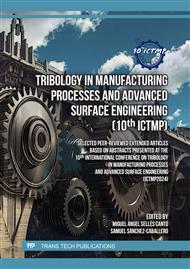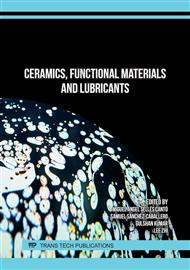[1]
Claudin C, Mondelin A, Rech J, Fromentin G. Effects of a straight oil on friction at the tool–workmaterial interface in machining. Int J Mach Tools Manuf 2010;50:681–8.
DOI: 10.1016/j.ijmachtools.2010.04.013
Google Scholar
[2]
Basten S, Kirsch B, Ankener W, Smaga M, Beck T, Uebel J, et al. Influence of different cooling strategies during hard turning of AISI 52100 - part I: thermo-mechanical load, tool wear, surface topography and manufacturing accuracy. Procedia CIRP 2020;87:77–82.
DOI: 10.1016/j.procir.2020.02.085
Google Scholar
[3]
Liu H, Meurer M, Schraknepper D, Bergs T. Investigation of the cutting fluid's flow and its thermomechanical effect on the cutting zone based on fluid–structure interaction (FSI) simulation. Int J Adv Manuf Technol 2022;121:267–81.
DOI: 10.1007/s00170-022-09266-1
Google Scholar
[4]
Amrita M, Shariq SA, Manoj, gopal C. Experimental investigation on application of emulsifier oil based nano cutting fluids in metal cutting process. Procedia Eng 2014;97:115–24.
DOI: 10.1016/j.proeng.2014.12.231
Google Scholar
[5]
Singh V, Sharma AK, Sahu RK, Katiyar JK. Novel application of graphite-talc hybrid nanoparticle enriched cutting fluid in turning operation. J Manuf Process 2021;62:378–87.
DOI: 10.1016/j.jmapro.2020.12.017
Google Scholar
[6]
Gupta MK, Sood PK, Sharma VS. Optimization of machining parameters and cutting fluids during nano-fluid based minimum quantity lubrication turning of titanium alloy by using evolutionary techniques. J Clean Prod 2016;135:1276–88.
DOI: 10.1016/j.jclepro.2016.06.184
Google Scholar
[7]
Maruda RW, Krolczyk GM, Wojciechowski S, Powalka B, Klos S, Szczotkarz N, et al. Evaluation of turning with different cooling-lubricating techniques in terms of surface integrity and tribologic properties. Tribol Int 2020;148:106334.
DOI: 10.1016/j.triboint.2020.106334
Google Scholar
[8]
Ozcelik B, Kuram E, Huseyin Cetin M, Demirbas E. Experimental investigations of vegetable based cutting fluids with extreme pressure during turning of AISI 304L. Tribol Int 2011;44:1864–71.
DOI: 10.1016/j.triboint.2011.07.012
Google Scholar
[9]
Pape F, Poll G, Ellersiek L, Denkena B, Liu H. Tribological Effects of Metalworking Fluids in Cutting Processes. Lubricants 2023;11:224.
DOI: 10.3390/lubricants11050224
Google Scholar
[10]
Ma J, Gali OA, Riahi RA. An Evaluation of the Tribological Behavior of Cutting Fluid Additives on Aluminum-Manganese Alloys. Lubricants 2021;9:84. https://doi.org/10.3390/ lubricants9080084.
DOI: 10.3390/lubricants9080084
Google Scholar
[11]
Schulz J, Brinksmeier E, Meyer D. On the Interactions of Additives in Metalworking Fluids with Metal Surfaces. Lubricants 2013;1:75–94.
DOI: 10.3390/lubricants1040075
Google Scholar
[12]
Zabel A, Saelzer J, Elgeti S, Alammari Y, Berger S, Biermann D. Fundamental tribological effects in lubricated cutting processes. CIRP Ann 2023:S0007850623000811.
DOI: 10.1016/j.cirp.2023.04.045
Google Scholar
[13]
Huang C, Lee S, Sullivan JP, Chandrasekar S. In Situ Measurement of Fluid Film Thickness in Machining. Tribol Lett 2007;28:39–44.
DOI: 10.1007/s11249-007-9245-6
Google Scholar
[14]
Courbon C, Sterle L, Cici M, Pusavec F. Tribological Effect of Lubricated Liquid Carbon Dioxide on TiAl6V4 and AISI1045 under Extreme Contact Conditions. Procedia Manuf 2020;47:511–6.
DOI: 10.1016/j.promfg.2020.04.139
Google Scholar



